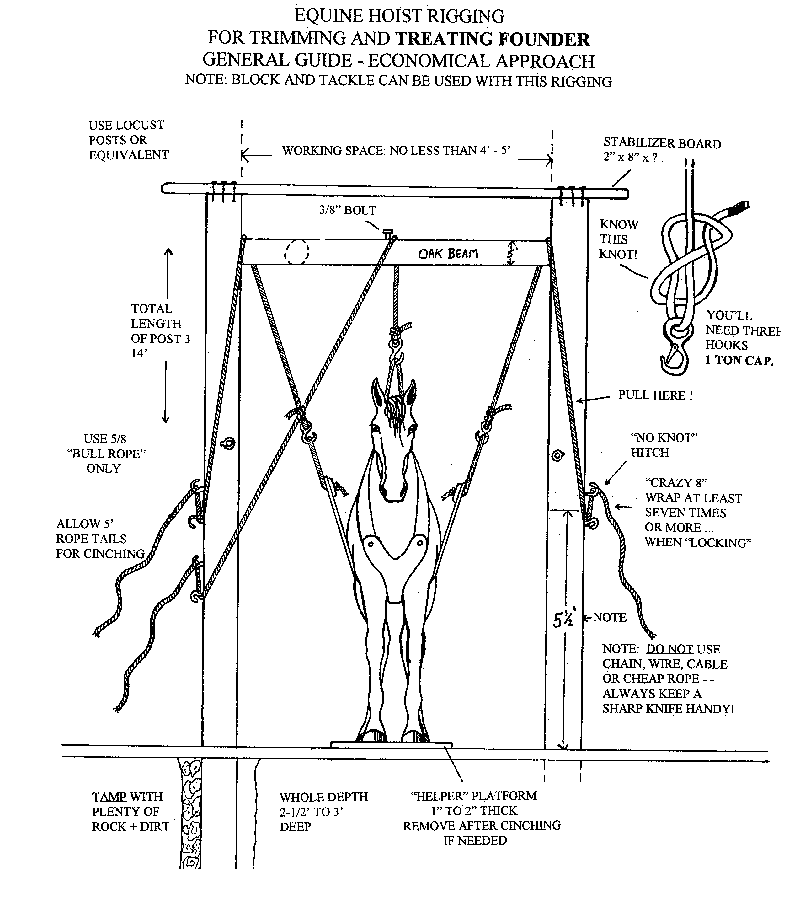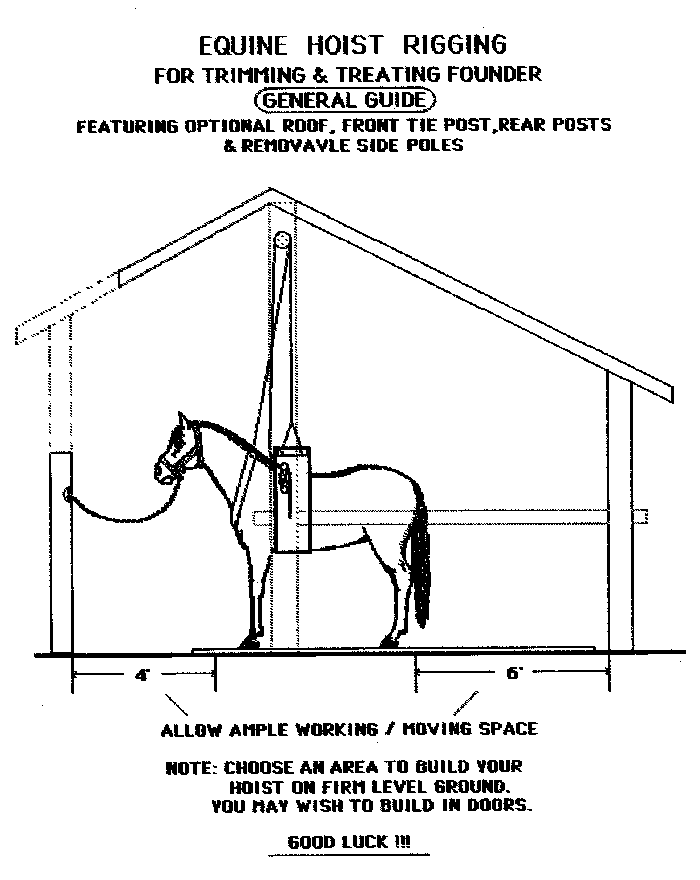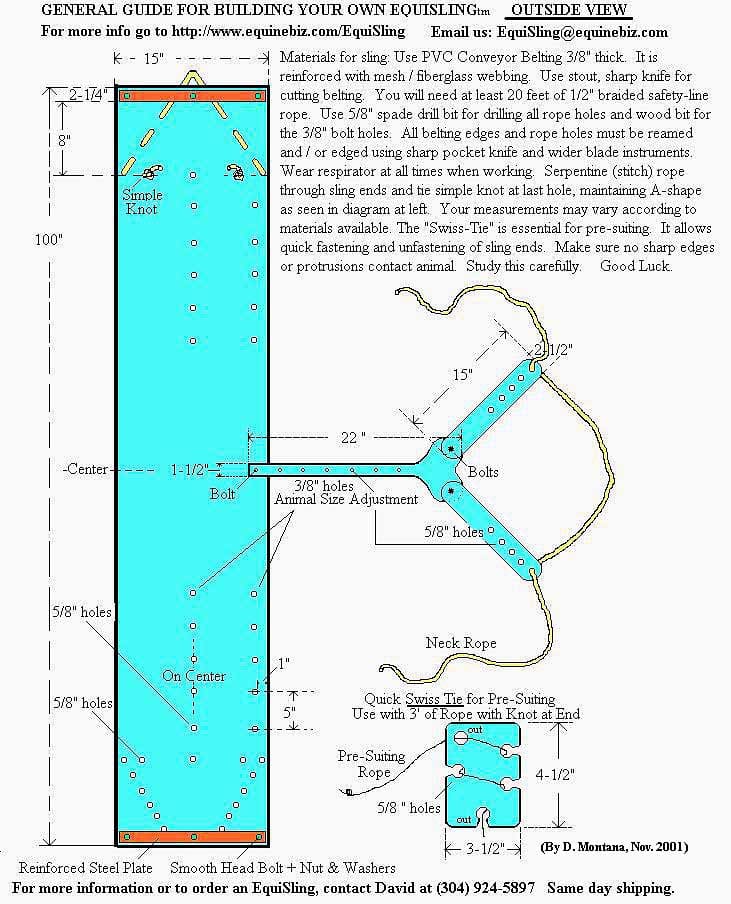
USING A SLING FOR TRIMMING SEVERELY SORE HORSES

| Gretchen Fathauer's introductory comments:
David Montana rescued a severely foundered young Standardbred/TWH stud. On the rare occasions when this horse was standing, he was actually walking entirely on his hind feet, his front feet were so sore. Apparently he had had his front hooves completely slough off earlier, but the new ones that had grown back were greatly over-grown and turned up like ski tips. (It was at this point that David first saw him.) What is all the more tragic, he is not yet quite 3 years old. Anyway, David bought him on sight, determined to help this poor animal, and if nothing else, to at least get him out of 24 hour stall confinement. He now is in a large field with a mare, which made him a happy boy right away! A month after the trimming began, he was still a little ouchy, but he often forgot himself, and has been seen galloping to catch up with his mare, and doing a floating trot to impress her on occasion. David has seen considerable structural improvements in his feet as well. 6 weeks after beginning the trim, the stallion was doing collected, in-place trots and canters for his mare, and walking sound in the field. However, this horse had more setbacks later, due to so much coffin bone loss, and eventually, he was put down. Trying to trim a horse as sore as this stud was in the beginning is almost impossible and extremely dangerous, unless you attempt to do it while he is lying down, which is dangerous. Trying to get under him and hold up a foot is even more dangerous--he is likely to fall on you. David is rather inventive, and also has a lot of familiarity with heavy duty rigging as well as access to the right materials, as he is a tree surgeon. David rigged up a sling to allow the stallion to take some weight off his other front foot when one is being worked on. The horse soon got to like this arrangment, and gives a foot quite willingly in the sling, but won't do it yet when he's out of the sling. Owners of severely foundered, sore horses can order a sling from David directly. He will take calls up to midnight EST. David Montana, Rt. 1, Box 28, French Creek, WV 26218; Phone: 304-924-5897 www.equinebiz.com/EquiSling (The following material is what David sent me, including the illustrations. It includes detailed plans and instructions so you can make your own sling. He refers to using "locust posts." We in the Appalachians use locust posts to build fence because they do not rot readily in the ground. An alternative more generally available, though, is a treated 6" x 6".) |
David Montana wrote:
"I have owned horses over a 25 year stretch and have never had any of them shod. I have ridden them through all types of terrain, and year-round through all types of weather. All of these horses have maintained strong, healthy feet. Of course, when riding your horse barefoot, you must use good judgment in how you go about it. You are the leader, your horse is the follower. You can maintain his trust using common sense.
"Recently, I purchased a 3-year-old Walker/Standardbred stallion who had foundered and had sloughed off his front hooves and grown new ones. He had been through hell, but his feet seemed pretty good, considering. Even his hoof rings were small and barely noticeable. He did not care to lift his leg for me, due to putting all the pressure on his other leg. Also, working on his feet while he is lying down can be quite awkward and troublesome.
"When I built my stable, I incorporated a hoist rigging, poles, and beam into its design. So, all I needed to do was build my foundered horse a harness. After cinching him up in harness, with no trouble from him whatsoever, he gladly let me work on all four hooves and he seemed quite at ease and happy with this situation. Note: he was also much more inclined to allow me to work on his rear hooves due to the frontal security and support of the harness.
"Treating a foundered horse is hard enough as it is. Your efforts will be cut in half and healing for the the horse will speed up, having a hoist and harness. Remember, this particular horse rigging that I have discussed is only general information (the main idea). Use some of your own ideas, or maybe a friend or professional could help you. Or, if you wish, you can call me anytime at 304-924-5897. I am usually up until midnight EST and would be glad to speak with you. Also, if you would like to order a custom-made harness, I can sell you one.
"Most often horses founder on the front hooves. This method and means is specifically designed to deal with frontal founder, although it also makes it much easier to trim the healthy rear hooves due to the support of this harness. You may work on your horse's feet when it is lying down, but I know this could be limited, a bit awkward, and dangerous. Having a hoist rigging and harness is not only an awesome thing to have for treating founder, but it is also useful for treating other lameness problems and for just general trimming sessions, particularly with horses that are restless. This method and means is just to give you some ideas. You must use some of your own judgment to fill in the blanks, because everyone has different materials available. You have to use what you can buy.
"AVOID using steel cable, chain, wire, or cheap rope. If you can't cut it with a sharp knife in an emergency, don't use it. Keep a sharp knife handy and avoid leaving your horse unattended while in harness. When constructing a hoist, it is advisable to make it strong enough and tall enough to handle a large horse. When working with horses and rigging, there are always dangers, so always use caution, particularly from getting kicked and fingers getting pinched in ropes. Since you are only pulling the horse up enough to take some weight off his front feet, rather than completely suspend him in air, he is less likely to panic, and he will be in no danger of falling. But, he is a horse, so please be careful. Block and tackle can definitely be used with this rigging. Again, use your judgment on what's best for you.
"Note: When constructing any type of harness, it is important that it be very strong. Also, it is necessary that it be comfortable to the horse, paying close attention to allow adequate circulation in the chest and in between the front legs. To obtain this, use ample padding and extend the padding over and around the edges, at least where it comes in contact with your horse."

Tools and materials list--equine hoist
Supplies:
2 locust posts, 14' long, 8" diameter at the fat end (alternatively, treated 6" x 6" x 14')
1 oak or hardwood hoisting beam, about 8' long, 5" diameter, and cut to length and fitted after posts are firmly set into the ground
1--2" x 4" x 8' top board to hold post spacing across the top.
40' of 5/8" bull rope (Available from Blue Ridge Arborist Supply, 1-800-577-8733--or from David Gorin)
3 hoisting hooks
6--3/8" lag bolt hooks for tie-ups, cinching, sailor's hitch
2--3/8" eyebolts for "cross-tying"
2--4" x 1/2" lag bolts with non-threaded neck of at least 1" for rope guides at top center of hoisting beam
Tools:
Chain saw
Powerful drill with several bit sizes
Spud bar--one end has spade for digging and chopping, other end is flat for crushing and tamping
If using logs for posts, use hatchet or draw knife for de-barking
Shovel
(After notching your lateral posts to accommodate your hoisting beam, decide which extra lag bolts and their sizes you will need. There are many variations of constructing them and making them strong. Have a friend or professional builder help you decide how you will secure your hoisting beam.)
REMEMBER: It must support the weight of your horse, and your horse lurching forward, backward, to and fro. You want to feel safe and be safe. Making it stronger than it seems to be necessary is best.

Tools and materials list--equine harness
Supplies:
1--15" x 10' conveyor belt (reinforced rubber) 3/8" thick
Cushioning material--foam, folded wool, etc.
Cushioning cover material--canvas or wool Army blanket
12--2" x 1/4" convex-headed bolts with nuts and washers
Duct tape or electrical tape (optional)
2 pieces of 5/8" bull rope at least 3' long each
2--1" x 4" x 15" oak boards
Box of 3/8" driving depth x 1/8" wide-headed, self-tapping screws for securing cover material to harness
(Note: allow your cover material to pleat deliberately, so that it will not stretch or rip while in use. There are many different ways to fasten your cover material to the harness. This is one of them.)
Tools:
Powerful drill, preferably variable speed, with several drill bit sizes and Phillips head self-tapping screw bit
Thin-bladed, sharp knives
Round wood file for reaming out holes
Flat wood file for smoothing edges
(Note: bolts should fit snugly when pressed into their intended slots, as should the bull rope.)
Back to home page--Table of Contents
Article in sections with "thumbnail" photos for fastest downloads:
1 9 17
2 10 18
3 11 19
4 12 20
5 13 21
6 14 22
7 15 23
8 16 24
NAVICULAR
Article in sections with full-sized photos for print-outs:
1 9 17
2 10 18
3 11 19
4 12 20
5 13 21
6 14 22
7 15 23
8 16 24
NAVICULAR
To Strasser case studies--thumbnail photos for faster downloads
To Strasser case studies--large photos
Please sign my guest book! Photos of my pets My farm
Share Barefoot success stories on this page
Buy or sell used HORSE BOOTS Natural board Barn Listings
Click here to subscribe to naturalhorsetrim
(I moderate this listserv to weed out "fluff.")
Send Email to Gretchen Fathauer, or call (740) 674-4492
Copyright by Gretchen Fathauer, 2015. All rights reserved.